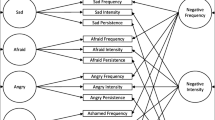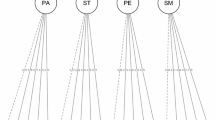Abstract
The purpose of the present research was to develop and evaluate a novel conceptual model and measure of Tolerance of Negative Affective States (TNAS). Exploratory factor and parallel analyses and subsequent confirmatory factor analyses supported a hierarchical multi-dimensional model of TNAS. We observed one higher-order factor, labeled Tolerance of Negative Emotions, and six lower-order factors, including, FI Tolerance of Fear-Distress, FII Tolerance of Sadness-Depression, FIII Tolerance of Anger, FIV Tolerance of Disgust, FV Tolerance of Anxious-Apprehension, and FVI Tolerance of Negative Social Emotions. A series of tests documented that TNASS sub-scale scores demonstrate internal consistency as well as convergent and discriminant validity. We discuss the findings with respect to understanding the nature of the emergent TNAS construct and its measurement.
Similar content being viewed by others
Notes
In contrast to other identified emotions and affective states, the emotion construct/term contempt was not included. Relative to other emotions, contempt has been identified as potentially unfamiliar and inaccessible and therefore unreliably reported upon by research subjects (Wagner 2000). Moreover, relative to other identified affective states, contempt has been scrutinized as a discrete emotion (Russell 1994).
References
American Psychiatric Association. (2000). Diagnostic and statistical manual of mental disorders (4th ed., text rev.). Washington, DC: Author.
Barlow, D. H. (2002). Anxiety and its disorders (2nd ed.). New York: Guilford.
Barlow, D. H., Allen, L. B., & Choate, M. L. (2004). Toward a unified treatment for emotional disorders. Behavior Therapy, 35, 205–230.
Bentler, P. M., & Bonett, D. G. (1980). Significance tests and goodness of fit in the analysis of covariance structures. Psychological Bulletin, 88(3), 588–606. doi:10.1037/0033-2909.88.3.588.
Bentler, P. M. (1990). Comparative fit indexes in structural models. Psychological Bulletin, 107, 238–246.
Bernstein, A., Trafton, J., Ilgen, M., & Zvolensky, M. J. (2008). An evaluation of the role of smoking context on a biobehavioral index of distress tolerance. Addictive Behaviors, 33, 1409–1415.
Bernstein, A., Zvolensky, M. J., Vujanovic, A. A., & Moos, R. (2009). Anxiety sensitivity, distress tolerance, and discomfort intolerance: A hierarchical model of affect sensitivity and Tolerance. Behavior Therapy, 40, 291–301.
Bernstein, A., Marshall-Berenz, E. C., & Zvolensky, M. J. (2011a). Multi-method evaluation of distress tolerance measures and construct(s): Concurrent relations to mood and anxiety psychopathology and quality of life. Journal of Experimental Psychopathology, 2(3), 386–399.
Bernstein, A., Vujanovic, A. A., Leyro, T., & Zvolensky, M. J. (2011b). Distress tolerance: Research synthesis and future directions. In M. J. Zvolensky, A. Bernstein, & A. A. Vujanovic (Eds.), Distress tolerance. New York, NY: Guilford Press.
Bollen, K. A. (1989). Structural equations with latent variables. Oxford, UK: John Wiley & Sons.
Brislin, R. W. (1970). Back-translation for cross-cultural research. Journal of Cross-Cultural Psychology, 1, 185–216.
Brown, K. W., & Ryan, R. M. (2003). The benefits of being present: Mindfulness and its role in psychological wellbeing. Journal of Personality and Social Psychology, 8, 822–848. doi:10.1037/0022-3514.84.4.822.
Browne, M. W., & Cudeck, R. (1993). Alternative ways of assessing model fit. In K. A. Bollen & J. S. Long (Eds.), Testing structural equation models (pp. 136–162). Newbury Park, CA: Sage.
Byrne, B. M. (2009). Structural equation modeling with AMOS: Basic concepts, applications, and programming (2nd ed.). New York: Routledge/Taylor & Francis.
Campbell, D. T., & Fiske, D. W. (1959). Convergent and discriminant validation by the multitrait-multimethod matrix. Psychological Bulletin, 56, 81–105.
Ekman, P. (1999). Basic emotions. In T. Dalgleish & M. Power (Eds.), Handbook of cognition and emotion. New York: Wiley.
Fabrigar, L. R., Wegener, D. T., MacCallum, R. C., & Strahan, E. J. (1999). Evaluating the use of exploratory factor analysis in psychological research. Psychological Methods, 4, 272–299.
Geisinger, K. F. (1994). Cross-cultural normative assessment: Translation and adaptation issues influencing the normative interpretation of assessment instruments. Psychological Assessment, 6, 304–312.
Gorsuch, R. (1983). Factor Analysis. London: Lawrence Erlbaum Associates.
Gratz, K. L., & Roemer, L. (2004). Multidimensional assessment of emotion regulation and dysregulation: Development, factor structure, and initial validation of the difficulties in emotion regulation scale. Journal of Psychopathology and Behavioral Assessment, 26, 41–54.
Hayes, S. C., Strosahl, K., & Wilson, K. G. (1999). Acceptance and commitment therapy: An experiential approach to behavior change. New York: Guilford Press.
Hayes, S. C., Strosahl, K., Wilson, K. G., Bissett, R. T., Pistorello, J., & Toarmino, D. (2004). Measuring experiential avoidance: A preliminary test of a working model. Psychological Record, 54, 553–578.
Haynes, S. N., Richard, D. C. S., & Kubany, E. S. (1995). Content validity in psychological assessment: A functional approach to concepts and methods. Psychological Assessment, 7, 238–247.
Hayton, J. C., Allen, D. G., & Scarpello, V. (2004). Factor retention decisions in exploratory factor analysis: A tutorial on parallel analysis. Organizational Research Methods, 7, 191–205.
Hooper, D., Coughlan, J., & Mullen, M. (2008). Structural equation modeling: guidelines for determining model fit. Electronic Journal of Business Research Methods, 6, 53–60.
Horn, J. L. (1965). A rationale and test for the number of factors in factor analysis. Psychometrika, 30, 179–185.
Hu, L.-T., & Bentler, P. (1995). Evaluating model fit. In R. H. Hoyle (Ed.), Structural Equation Modeling. Concepts, Issues, and Applications (pp. 76–99). London: Sage.
Hu, L., & Bentler, P. M. (1999). Cutoff criteria for fit indexes in covariance structure analysis: Conventional criteria versus new alternatives. Structural Equation Modeling: A Multidisciplinary Journal, 6(1), 1–55. doi:10.1080/10705519909540118
Izard, C. E. (1977). Human emotions. New York: Plenum Press.
Izard. C. E., Dougherty. F. E., Bloxom. B. M. L., and Kotsch, W. E. (1974). The Differential Emotions Scale: A method of measuring the subjective experience of discrete emotions. Unpublished manuscript. Vanderbilt University. Nashville. TN.
Jaccard, J., & Wan, C. K. (1996). LISREL approaches to interaction effects in multiple regression. Thousand Oaks, CA: Sage Publications, Inc.
James, L. R., Mulaik, S. A., & Brett, J. M. (1982). Causal analysis: Assumptions, models, and data. Beverly Hills, CA: Sage.
Kaiser, H. F. (1960). The application of electronic computers to factor analysis. Educational and Psychological Measurement, 20, 141–151.
Keltner, D. (1995). The signs of appeasement: Evidence for the distinct displays of embarrassment, amusement and shame. Journal of Personality and Social Psychology, 68, 441–454.
Larsen, R. J., & Fredrickson, B. L. (1999). Measurement issues in emotion research. In D. Kahneman, E. Diener, & N. Schwarz (Eds.), Well-being: The foundations of hedonic psychology (pp. 40–60). New York: Russell Sage Foundation.
Leyro, T. M., Zvolensky, M. J., & Bernstein, A. (2010). Distress tolerance and psychopathological symptoms and disorders: A review of the empirical literature among adults. Psychological Bulletin, 136, 576–600.
Linehan, M. M. (1993). Cognitive-behavioral treatment of borderline personality disorder. New York, NY: Guilford Press.
MacCallum, R. C., Widaman, K. F., Zhang, S., & Hong, S. (1999). Sample size in factor analysis. Psychological Methods, 4, 84–99.
Marlatt, G. A., & Gordon, J. R. (1985). Relapse prevention: Maintenance strategies in addictive behavior change. New York: Guilford.
Matthews, G., Deary, I. J., & Whiteman, M. C. (2003). Personality traits (2nd ed.). Cambridge: Cambridge University Press.
McHugh, R. K., Daughters, S. B., Lejuez, C. W., Murray, H. W., Hearon, B. A., Gorka, S. M., and Otto, M. W. (2011). Shared variance among self-report and behavioral measures of distress intolerance. Journal of Cognitive Therapy and Research, 35(3), 266–275. doi:10.1007/s10608-010-9295-1.
McIntosh, C. N. (2007). Rethinking fit assessment in structural equation modelling: A commentary and elaboration on barrett (2007). Personality and Individual Differences, 42(5), 859–867.
Messick, S. (1995). Validity of psychological assessment: validation of inferences from persons’ responses and performances as scientific inquiry into score meaning. American Psychologist, 50, 741–749.
O’Connor, B. P. (2000). SPSS and SAS programs for determining the number of components using parallel analysis and Velicer’s MAP test. Behavior Research Methods, Instruments, and Computer, 32, 396–402.
Olatunji, B. O., & Wolitzky-Taylor, K. B. (2009). Anxiety sensitivity and the anxiety disorders: A meta-analytic review and synthesis. Psychological Bulletin, 135, 974–999.
Orsillo, S. M., & Roemer, L. (2005). Acceptance and mindfulness-based approaches to anxiety: Conceptualization and treatment. New York: Springer.
Russell, J. A. (1994). Is there universal recognition of emotion from facial expression? Psychological Bulletin, 115, 102–141.
Schumacker, R. E., & Lomax, R. G. (2004). A beginner’s guide to structural equation modeling, Second edition. Mahwah, NJ: Lawrence Erlbaum Associates.
Simons, J., & Gaher, R. (2005). The Distress Tolerance Scale: Development and validation of a self report measure. Motivation and Emotion, 29, 83–102.
Tangney, J. P., Miller, R. S., Flicker, L., & Barlow, D. H. (1996). Are shame, guilt, and embarrassment distinct emotions? Journal of Personality and Social Psychology, 70, 1256–1269.
Van de Vijver, F. J. R., & Hambleton, R. K. (1996). Translating tests: Some practical guidelines. European Psychologist, 1, 89–99.
Wagner, H. L. (2000). The accessibility of the term “contempt” and the meaning of the unilateral lip curl. Cognition and Emotion, 14, 689–710.
Watson, D., Clark, L. A., & Tellegen, A. (1988). Development and validation of the brief measures of positive and negative affect: The PANAS scales. Journal of Personality and Social Psychology, 54, 1063–1070.
Zvolensky, M. J., Arrindell, W. A., Taylor, S., Bouvard, M., Cox, B. J., & Stewart, S. H. (2003). Anxiety sensitivity in six countries. Behaviour Research and Therapy, 41, 841–859.
Zvolensky, M. J., Vujanovic, A. A., Bernstein, A., & Leyro, T. (2010). Distress tolerance: Theory, measurement, and relations to psychopathologyy. Current Directions in Psychological Science, 19, 406–410.
Zvolensky, M. J., Bernstein, A., & Vujanovic, A. A. (Eds.). (2011a). Distress tolerance. New York: Guilford Press.
Zvolensky, M. J., Leyro, T., Bernstein, A., & Vujanovic, A. A. (2011b). Distress tolerance: Historical perspectives, theory, and measurement. In M. J. Zvolensky, A. Bernstein, & A. A. Vujanovic (Eds.), Distress tolerance. New York, NY: Guilford Press.
Acknowledgments
Dr. Bernstein recognizes the funding support from the Israeli Council for Higher Education Yigal Alon Fellowship, the European Union FP-7 Marie Curie Fellowship International Reintegration Grant, the Israel Science Foundation, the National Institute on Drug Abuse Clinical LRP, Psychology Beyond Borders Mission Award, the University of Haifa Research Authority, and the Rothschild-Caesarea Foundation’s Returning Scientists Project at the University of Haifa.
Author information
Authors and Affiliations
Corresponding author
Appendix 1: TNASS
Appendix 1: TNASS
Below, you will be asked to rate how tolerant you are of a number of emotions.
First, please read the following description of tolerance and intolerance of emotions until it is clear to you.

Now, please think about instances in the past year in which you felt each emotion listed below. Then, please rate how tolerant you typically were of feeling each emotion over the past year.
Please check only one box per emotion item below. Please complete all items. Remember, there are no right or wrong answers.

Rights and permissions
About this article
Cite this article
Bernstein, A., Brantz, H. Tolerance of Negative Affective States (TNAS): Development and Evaluation of a Novel Construct and Measure. Cogn Ther Res 37, 421–433 (2013). https://doi.org/10.1007/s10608-012-9471-6
Published:
Issue Date:
DOI: https://doi.org/10.1007/s10608-012-9471-6




